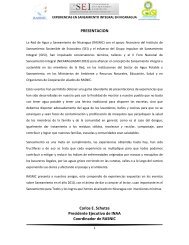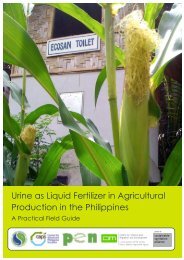<strong>Open</strong> <strong>Planning</strong> <strong>of</strong> <strong>Sanitation</strong> <strong>Systems</strong>BackgroundApproximately two fifths <strong>of</strong> the population in the world lack basic sanitation facilitiestoday. Basic sanitation is defined by WHO as being connected to a public sewer or septictank system, a pour-flush latrine, a simple pit latrine or ventilated improved pit latrine. Thislack <strong>of</strong> sanitation was highlighted during the World Summit on Sustainable Development inJohannesburg, 2002, where the Millennium Development Goal set to halve the proportion <strong>of</strong>the population without access to safe drinking water was amended to also include a reductionby half <strong>of</strong> the proportion <strong>of</strong> the world population without access to basic sanitation by 2015(UN, 2003). It is clear that a massive effort is needed to reduce this sanitation backlog in thecoming eleven years. Moreover, it is <strong>of</strong> utmost importance that the concept <strong>of</strong> sustainabilityis considered in regard to sanitation during investments and planning for sanitation upgrade:what is needed in order to supply a sanitation system that will be sustainable from a social, aswell as an economical and environmental perspective? In providing what may be considered astechnically well-functioning systems, we might risk ignoring the broader issues <strong>of</strong> sanitation,which include environmental protection and human health, the important social aspects <strong>of</strong>sanitation and broader economic aspects. An integrated view <strong>of</strong> sanitary planning where thesanitation planner is moving beyond figures <strong>of</strong> initial investment, operation and maintenancecost is required to supply sustainable sanitation.One way <strong>of</strong> reaching beyond the provision <strong>of</strong> purely technical solutions to sanitation is t<strong>of</strong>ocus on what criteria future sanitation systems should comply to in order to be sustainablein given settings. Such ‘criteria thinking’, or ‘functional requirements thinking’, can be usedboth on a macro level, by including criteria <strong>of</strong> sustainable sanitation in terms <strong>of</strong> referencefor sanitation projects financed on an international level, down to the micro level where thediscussions around sanitation investments in a municipality should be guided rather around thefunction requirements <strong>of</strong> the planned system than around sanitation techniques. By focusingon the function <strong>of</strong> a sanitation system rather than the technology itself, more room will beallowed for innovative solutions to sanitary problems (Tischner and Schmidt-Bleek, 1993).OBJECTIVEThe objective <strong>of</strong> this capacity-building project was to produce a tentative manual for theplanning and implementation <strong>of</strong> sanitation projects based on sanitation system functionrequirements rather than sanitation technologies, in order to supply sustainable sanitationsystems. The manual is intended to create and support an open and democratic sanitationplanning process and is aimed at planners and implementers at project level.METHODOLOGYThe <strong>Open</strong> Comparative Consequence Analysis MethodThe planning and implementation tool presented in this report is based on the <strong>Open</strong> ComparativeConsequence Analysis (OCCA) methodology that has been developed in Sweden by WRSUppsala AB (Ridderstolpe, 2000).Fundamental to OCCA planning is the recognition that the desired result, sustainablehousehold sanitation, can be achieved by utilization <strong>of</strong> different sanitation technologies.Ultimately, all factors influencing the sustainability <strong>of</strong> a sanitation system, such as local1
Elisabeth Kvarnström and Ebba af Petersensconditions, applicable regulations and user preference must guide the choice <strong>of</strong> a sanitationsolution. This will ensure that the system most appropriate and sustainable for a specificcommunity and its economic and environmental situation is selected. This approach alsoallows the promotion <strong>of</strong> new and innovative sanitation techniques, which is in accordance withthe BAT (Best Available Technique) principle that is a part <strong>of</strong> the environmental legislation inmany countries.The OCCA concept is based on the establishment <strong>of</strong> a set <strong>of</strong> criteria describing the functionrequirements or targets to be achieved by a sanitation system. These criteria are context-specificand are identified in cooperation with relevant stakeholders. They cover practical, economicand institutional aspects and are described in so-called Terms <strong>of</strong> Requirement (ToR). The ToRare then used to assess the merits <strong>of</strong> various sanitation alternatives. A final choice is then madefrom those alternatives fulfilling the needs outlined in the ToR.The Concept <strong>of</strong> Sustainability in Relation to <strong>Sanitation</strong>In this report we consider sanitation systems sustainable if they protect and promote humanhealth, do not contribute to environmental degradation or depletion <strong>of</strong> the resource base, aretechnically and institutionally appropriate, economically viable and socially acceptable 1 .A sanitation system encompasses, in our view, the users <strong>of</strong> the system, the collection,transport, treatment and management <strong>of</strong> the end products <strong>of</strong> human excreta, solid waste,industrial wastewater and storm water.A tentative list <strong>of</strong> criteria that might be <strong>of</strong> importance for sustainability in relation tosanitation is provided in Appendix 1.<strong>Open</strong> <strong>Planning</strong> <strong>of</strong> <strong>Sanitation</strong> <strong>Systems</strong>This methodology has been further developed into the <strong>Open</strong> <strong>Planning</strong> <strong>of</strong> <strong>Sanitation</strong> <strong>Systems</strong>concept by using results from:• a suggestion <strong>of</strong> criteria for sustainability in relation to sanitation, Appendix 1 2 ;• a survey about existing sanitation planning and implementation tools, presented inAppendix 2; and• views <strong>of</strong> selected sanitation pr<strong>of</strong>essionals as presented in Appendix 3.1 This definition <strong>of</strong> sustainability in relation to sanitation was agreed upon at a meeting held by EcoSanRes andGTZ, see Preface.2 The suggestion for criteria to consider for sustainability in relation to sanitation was identified during a meetingheld jointly by EcoSanRes and GTZ, see Preface for details.2



![Project Document [PDF: 2.31 MB] - EcoSanRes](https://img.yumpu.com/51279385/1/184x260/project-document-pdf-231-mb-ecosanres.jpg?quality=85)












![Latrines à compost [high-resolution colour PDF: 12.3MB] - EcoSanRes](https://img.yumpu.com/31726141/1/185x260/latrines-a-compost-high-resolution-colour-pdf-123mb-ecosanres.jpg?quality=85)